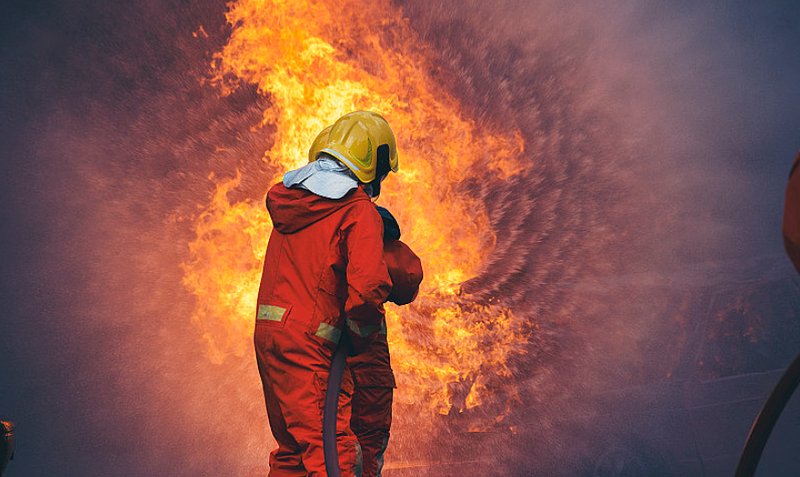Aerogel: From Nanopores to Life Defense Lines, Redefining the Future of High-Temperature Protection
Aerogel, a "solid blue smoke" with a porosity of up to 99.8%, is redefining high-temperature protection. Its nanoscale thermal insulation properties can extend firefighters' safety time at 800°C from 8 minutes to 25 minutes, while reducing equipment weight by at least 23%. From building insulation to industrial rescue, aerogel forms an invisible safety net. Thanks to its cost-effective drying process and intelligent adaptive technology, aerogel is expected to capture 60% of the global firefighting market by 2030.
1. A Thermal Insulation Miracle in the Nanoworld
In materials science, aerogel is often called a paradox. Despite being as light as mist—just 0.003 g/cm³—it creates a near-perfect thermal barrier. Its three-dimensional silica nanoparticles offer a porosity of up to 99.8%, meaning that the majority of its volume is filled with nanoscale cavities. This unique structure inhibits convective heat transfer, blocks conduction through the curved skeleton, and reduces radiation, resulting in an ultra-low thermal conductivity of 0.018—one-third lower than still air.
This impressive performance has been demonstrated in numerous cutting-edge applications:
NASA's Stardust mission (2004): Aerogel successfully captured cometary particles traveling at 6.1 km/s and preserved their fragile structure.
China's Tiangong space station: Aerogel supports thermal control in extreme temperature ranges (-200°C to 150°C). Fire test: When a 1 cm thick aerogel sheet was exposed to a direct flame of 1300°C, the temperature on the back side rose by only 2.8°C per minute - five times slower than fiberglass and three times slower than rock wool.
2. The Race Against Time in Firefighting and Rescue
For firefighters, every second counts. Traditional aramid flame-retardant clothing provides less than eight minutes of protection at 500°C. The addition of aerogel significantly extends this time.
When a 0.6 mm thick aerogel composite layer is incorporated into protective clothing, the inner layer temperature can be kept below 60°C for 15 minutes, even at 650°C. For example, during a chemical fire in 2022, firefighters wearing aerogel-reinforced protective clothing worked at 800°C for 25 minutes, setting an industry record.
Key Performance Data:
Gear weight can be reduced by 23%, alleviating the physical strain on firefighters.
Thermal Protection Performance (TPP) reaches 48 cal/cm², 35% higher than the national standard.
The Shenzhen Fire Brigade in China reported a 40% increase in average rescue time and a 67% reduction in heatstroke incidents.
Aerogel suits received real-world validation during the cleanup of the 2015 Tianjin Port explosion in China, where firefighters wearing aerogel suits were able to endure extreme heat longer, ensuring critical time for hazardous material disposal.

3. From Industrial Boilers to Everyday Life: Aerogels Create a Safety Net
Aerogel's lightweight protection extends beyond firefighting:
In steel and metallurgical workshops: Protective clothing thickness can be reduced from 8 mm to 3 mm, heat dissipation efficiency improved by 50%, and thermal burns reduced by 82%.
Welding gloves: Enhanced flexibility increases fingertip sensitivity by 37%, reducing operator errors.
Wildfire Fighting: Fire blankets are lighter (0.8 kg vs. 2.3 kg) and deploy faster (1.2 seconds), crucial for the "golden 90 seconds."
Polar Exploration: Aerogel cold-weather suits offer 60% greater insulation performance while being 40% thinner, making Antarctic expeditions safer and more maneuverable.
In the civilian market, flexible aerogel fabrics can maintain over 95% of their insulation performance after 2,000 bends, supporting high-performance protective clothing. Inspired by polar bear fur, biomimetic aerogels feature directional moisture channels that reduce internal humidity by 30%, eliminating the "sweating room" problem associated with traditional protective clothing.
By 2023, the global aerogel protection market is expected to reach $1.8 billion, with a compound annual growth rate of 29.7%, signaling the rise of a $100 billion security industry.
4. Breaking Bottlenecks: From Laboratory to Large-Scale Application
Cost has long been a limiting factor in aerogel adoption. Technological breakthroughs are now accelerating its commercialization:
Ambient pressure drying and silicon source replacement technologies have reduced costs from 380 yuan per square meter to a projected price of less than 200 yuan per square meter by 2025.
Phase-change aerogel (Lawrence Berkeley National Laboratory): Absorbs 150 joules per gram of heat at 780°C, forming a passive cooling layer.
Self-healing aerogel (German researchers): Repairs cracks through nanoscale polymerization, achieving a recovery rate of up to 92%.
Smart aerogel (University of Science and Technology of China): Dynamically adjusts its pore structure—closing for insulation at high temperatures and opening for ventilation at low temperatures.
Forecasts indicate that by 2030, 60% of global firefighting equipment will incorporate aerogel. With the help of 3D printing technology, firefighters may soon be able to customize lightweight, form-fitting protective components. Even more futuristic is the integration of the Internet of Things and aerogel. Embedded with microsensors, they track vital signs and environmental data in real time. Meanwhile, the aerogel's pores dynamically adjust to provide adaptive protection—a true "breathing armor."
From nanoscale pores to a life-saving defense, aerogel embodies the fusion of materials science and human safety. It proves that the lightest materials can bear the heaviest responsibilities.
At fire scenes, it's a firefighter's invisible shield.
On the industrial front lines, it's armor for workers.
In everyday life, it's a guardian of safety and comfort.
From furnaces to polar snowfields, from rescue operations to consumer wearables, aerogel is weaving a safety net for humanity's challenges in high temperatures. When "light as smoke" meets "heavy as life," aerogel represents more than just a materials revolution; it embodies our relentless pursuit of safety, resilience, and hope in extreme environments.
LATEST NEWS
Why Does Metal Feel Cold and Wood Feel Warm at the Same Room Temperature? Unveiling the Magic of Thermal Conductivity!
2025-11-20
Innovative Aerogel Pipe Insulation Boosting Efficiency in Energy Industries
2025-11-17
Ordering and Specification Guidance for Aerogel Sheet and Pipe Insulation Products
2025-11-17
Luminescent Concrete Transforms Global Architecture with Light and Design Freedom
2025-11-13
Aerogel: The Ultralight Revolution – Transforming Industries with Unmatched Versatility
2025-11-11
